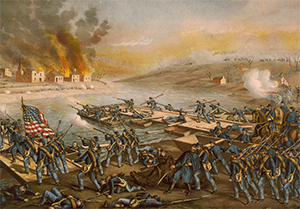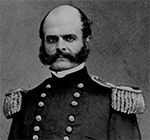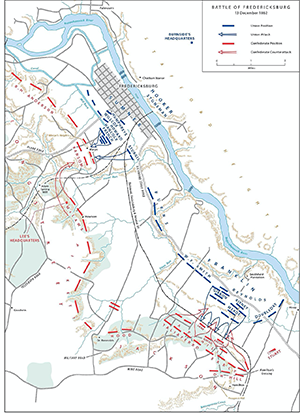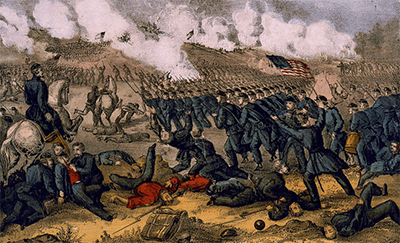The Battle of Fredericksburg
The Battle of Fredericksburg was a decisive Confederate victory during the American Civil War. The Union Army had scored a technical knockout of Robert E. Lee's Army of Northern Virginia at the Battle of Antietam in September 1862. The victory by the Army of the Potomac under Gen. George McClellan had convinced Lee to abandon his invasion of the north and Lincoln, Secretary of War Edwin Stanton, and the rest of the Union command team still wanted Union troops to march on Richmond, the capital of the Confederacy in order to seize it and to force Lee and his troops to defend it. Union troops marched to the southwest, converging on the town of Fredericksburg, which was south of Washington, D.C, down the Potomac River. The town was on the southern bank of the Rappahannock River, and Union troops would have to cross the river in order to attack the town. Burnside had decided that the way to do this was to use a number of pontoon bridges to ferry his troops across the river. The troops arrived long before the pontoon bridges did, and Burnside and his commanders decided not to risk having their soldiers wade across the river. While the Union troops waited for their pontoon bridges to arrive, Lee and his army, having not taken the bait, converged on Fredericksburg, filling it with Confederate troops. More importantly, they seized the high ground, installing big gun batteries and large numbers of troops on Marye's Heights and Prospect Hill that would be quite defensible as long as the ammunition did not run out. 
Under pressure from Lincoln and others in the high command, Burnside ordered an assault to begin on Dec. 11, 1862. The first order of business was to assemble the pontoon bridges. Those doing the assembling were soldiers and engineers, who completed their vital task while being subjected to withering enemy fire. Returning fire as much as possible, Union troops provided enough cover to enable the completion of the pontoon bridges, which the troops then used the following day to cross the river, again under hails of gunfire. On December 13, Burnside ordered a full assault all along the line. The Union troops marched across open ground, firing and reloading as they went, with the aim of reaching the high ground and dislodging the defenders. The total number of troops in the Union force for this battle was 120,000; Burnside, who on December 14 had announced his intention to take the field himself and lead yet another charge and had been talked out of it by his commanders, abandoned the assault entirely on December 15, and his troops retreated across the river. At the end of the battle, Union casualties numbered 12,653 (1,284 dead, 9,600 wounded, 1,769 captured or missing) and Confederate casualties numbered 5,377 (608 dead, 4,116 wounded, 653 captured or missing). Lincoln relieved Burnside of his command and replaced him with Maj. Gen. Joseph Hooker, who had led one of the futile assaults on Fredericksburg. |
|
Social Studies for Kids
copyright 2002–2025
David White



 retreat to Virginia.
retreat to Virginia.  Lincoln, Burnside and company decided that the next target for the Army of the Potomac should be Fredericksburg. However, the first action would be one of deception. Burnside planned to make it look like his troops were converging on an area southwest of Manassas, then move at great speed to the real target, Fredericksburg. The plan was to keep Lee guessing about the Union army's true target long enough for the Union troops to slip away unnoticed.
Lincoln, Burnside and company decided that the next target for the Army of the Potomac should be Fredericksburg. However, the first action would be one of deception. Burnside planned to make it look like his troops were converging on an area southwest of Manassas, then move at great speed to the real target, Fredericksburg. The plan was to keep Lee guessing about the Union army's true target long enough for the Union troops to slip away unnoticed. Confederate troops numbered 85,000. However, the defensive positions set up by Lee and
Confederate troops numbered 85,000. However, the defensive positions set up by Lee and 
